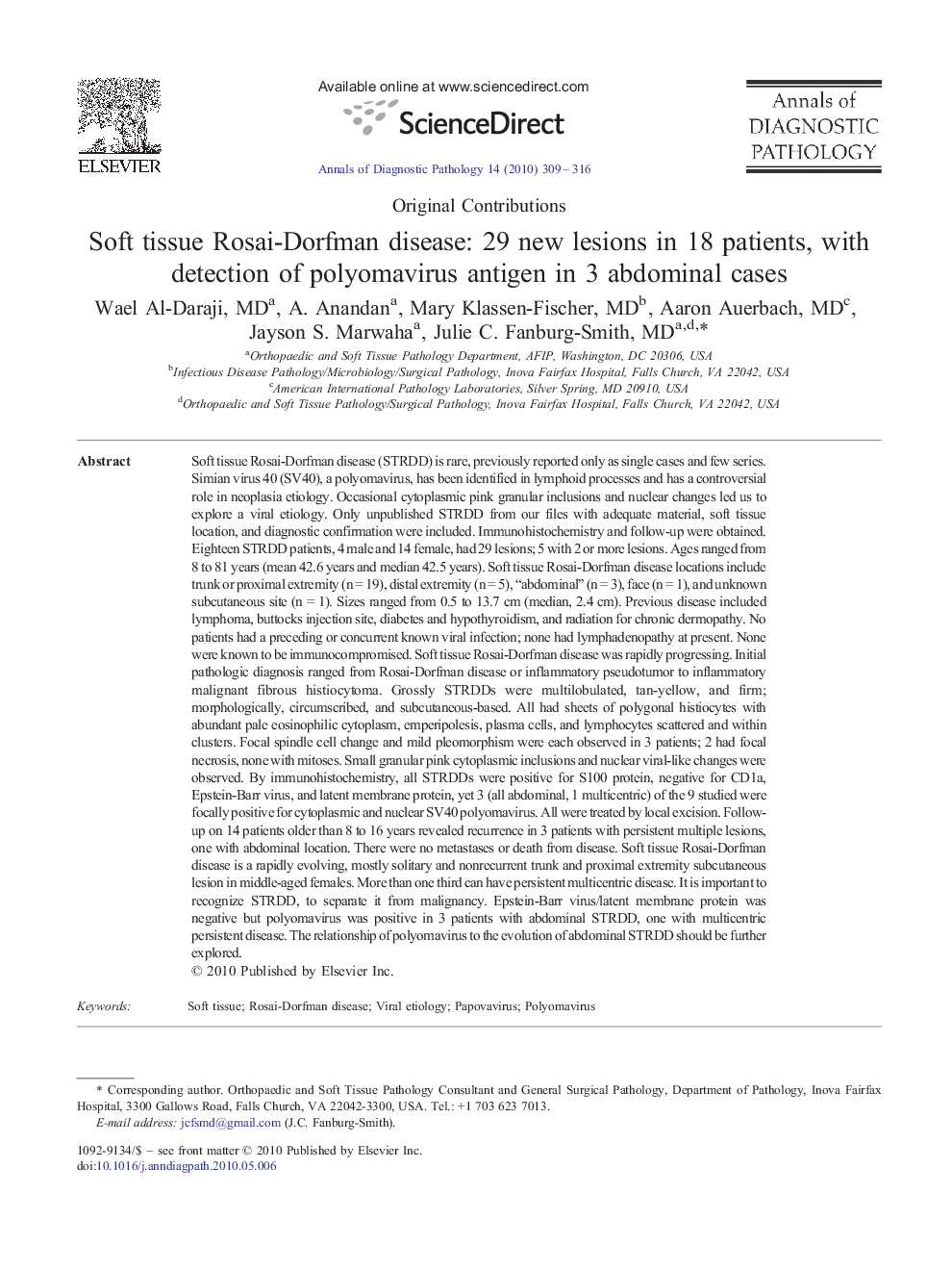| کد مقاله | کد نشریه | سال انتشار | مقاله انگلیسی | نسخه تمام متن |
|---|---|---|---|---|
| 4130155 | 1606507 | 2010 | 8 صفحه PDF | دانلود رایگان |

Soft tissue Rosai-Dorfman disease (STRDD) is rare, previously reported only as single cases and few series. Simian virus 40 (SV40), a polyomavirus, has been identified in lymphoid processes and has a controversial role in neoplasia etiology. Occasional cytoplasmic pink granular inclusions and nuclear changes led us to explore a viral etiology. Only unpublished STRDD from our files with adequate material, soft tissue location, and diagnostic confirmation were included. Immunohistochemistry and follow-up were obtained. Eighteen STRDD patients, 4 male and 14 female, had 29 lesions; 5 with 2 or more lesions. Ages ranged from 8 to 81 years (mean 42.6 years and median 42.5 years). Soft tissue Rosai-Dorfman disease locations include trunk or proximal extremity (n = 19), distal extremity (n = 5), “abdominal” (n = 3), face (n = 1), and unknown subcutaneous site (n = 1). Sizes ranged from 0.5 to 13.7 cm (median, 2.4 cm). Previous disease included lymphoma, buttocks injection site, diabetes and hypothyroidism, and radiation for chronic dermopathy. No patients had a preceding or concurrent known viral infection; none had lymphadenopathy at present. None were known to be immunocompromised. Soft tissue Rosai-Dorfman disease was rapidly progressing. Initial pathologic diagnosis ranged from Rosai-Dorfman disease or inflammatory pseudotumor to inflammatory malignant fibrous histiocytoma. Grossly STRDDs were multilobulated, tan-yellow, and firm; morphologically, circumscribed, and subcutaneous-based. All had sheets of polygonal histiocytes with abundant pale eosinophilic cytoplasm, emperipolesis, plasma cells, and lymphocytes scattered and within clusters. Focal spindle cell change and mild pleomorphism were each observed in 3 patients; 2 had focal necrosis, none with mitoses. Small granular pink cytoplasmic inclusions and nuclear viral-like changes were observed. By immunohistochemistry, all STRDDs were positive for S100 protein, negative for CD1a, Epstein-Barr virus, and latent membrane protein, yet 3 (all abdominal, 1 multicentric) of the 9 studied were focally positive for cytoplasmic and nuclear SV40 polyomavirus. All were treated by local excision. Follow-up on 14 patients older than 8 to 16 years revealed recurrence in 3 patients with persistent multiple lesions, one with abdominal location. There were no metastases or death from disease. Soft tissue Rosai-Dorfman disease is a rapidly evolving, mostly solitary and nonrecurrent trunk and proximal extremity subcutaneous lesion in middle-aged females. More than one third can have persistent multicentric disease. It is important to recognize STRDD, to separate it from malignancy. Epstein-Barr virus/latent membrane protein was negative but polyomavirus was positive in 3 patients with abdominal STRDD, one with multicentric persistent disease. The relationship of polyomavirus to the evolution of abdominal STRDD should be further explored.
Journal: Annals of Diagnostic Pathology - Volume 14, Issue 5, October 2010, Pages 309–316